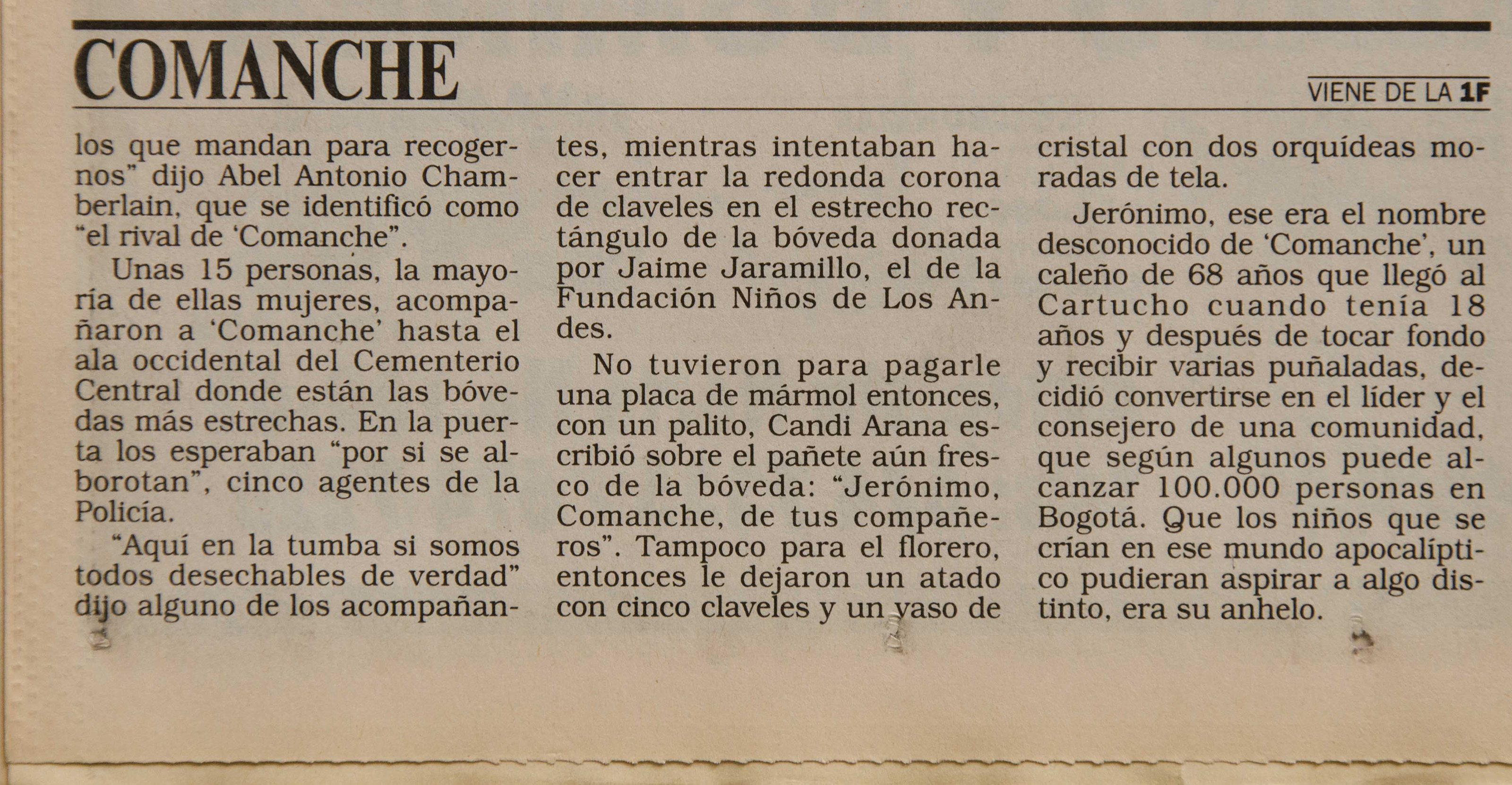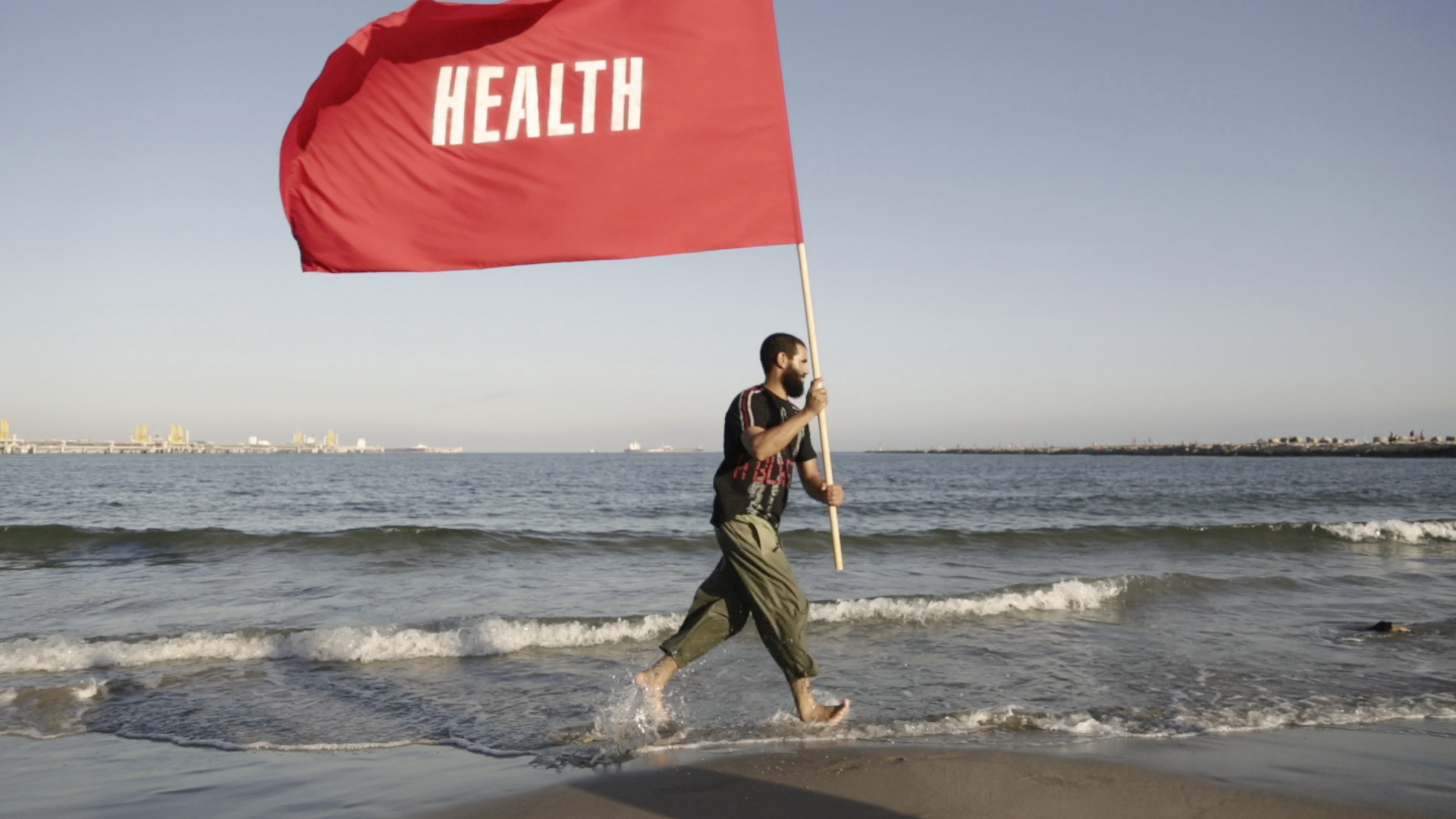
In Colombia, the peace deals with paramilitary groups and more recently with the FARC guerrilla allowed an official recognition of the political violence and its victims, and thus the necessity to canalize institutional efforts in the search for truth, memory, and peacebuilding. However, the official discourses of memory left behind an important phenomenon in Colombia’s long history of violence: the systematic assassination of the urban population considered “disposable” (homeless, drug addicts, gay and trans people, and sex workers) perpetrated by death squads and state actors, commonly known as “social cleansing.” It is worth noting that these processes of extermination so often come preceding urban renewal projects.
In order to make visible this horrific practice, CaldodeCultivo produced the project COMANCHE, COMMANDER OF THE HOMELESS, which
In order to make visible this horrific practice, CaldodeCultivo produced the project COMANCHE, COMMANDER OF THE HOMELESS, which
aimed to challenge the hegemonic gaze on local memory rescuing from oblivion the figure the leader of the homeless in Bogota back in the 90s who denounced and combated the extermination. Appropriating the language of the monumental, CaldodeCultivo built and installed a bust of Comanche, arranged a sound installation of a speech delivered by him, produced a polyphonic documentary, and created an archive that gathered unpublished images of the personage as well as national and international press on social cleansing.
The work had several resonances among the public and was finally required by the National Museum of Colombia to become part of its permanent exhibition. We consider this a significant victory since the ultimate objective of the project was to introduce Comanche and what he represents into the
The work had several resonances among the public and was finally required by the National Museum of Colombia to become part of its permanent exhibition. We consider this a significant victory since the ultimate objective of the project was to introduce Comanche and what he represents into the
official account of Colombia’s history.
Nonetheless, shortly after the opening of the room in the Museum where Comanche now resides, a visitor left the following message in the suggestion book: “Very unpleasant the space granted to that Comanche, head of the junkies, A DELINQUENT. Please REVIEW THIS ISSUE." Given this, the National Museum had to give a response that very well synthesizes the arrival of Comanche to the Museum:
“The objective the exhibition of Comanche at the Museum is to sensitize our different audiences about problems that were not part of the nation's narrative and about the existence of historically discriminated populations. Comanche was a very important social leader during the 90s in Bogotá. In addition to being a writer and poet, he organized the community of the former street of El Cartucho
Nonetheless, shortly after the opening of the room in the Museum where Comanche now resides, a visitor left the following message in the suggestion book: “Very unpleasant the space granted to that Comanche, head of the junkies, A DELINQUENT. Please REVIEW THIS ISSUE." Given this, the National Museum had to give a response that very well synthesizes the arrival of Comanche to the Museum:
“The objective the exhibition of Comanche at the Museum is to sensitize our different audiences about problems that were not part of the nation's narrative and about the existence of historically discriminated populations. Comanche was a very important social leader during the 90s in Bogotá. In addition to being a writer and poet, he organized the community of the former street of El Cartucho
(dismantled during the first decade of the 21st century in the framework of the war against drugs) to face the threat of the extermination practice known in Colombia as "social cleansing." This leader intervened before the Council of Bogotá denouncing the problem of abandonment and the systematic genocide of street people recorded by different media and academic studies during the last years of the 20th century. This piece seeks to make that reality visible and promote reflections on the value of life, in a country where some people have been qualified with the unjustifiable adjective of "disposable". Heterotopia is part of history and helps us think about the social and cultural processes that shape our present”.
Andrés Góngora, curator of Etnography at the National Museum of Colombia.
Andrés Góngora, curator of Etnography at the National Museum of Colombia.

With this project CaldodeCultivo sought to invoke the spirit of Comanche and put his word into circulation, in tribute to the thousands of violent deaths committed in the name of progress, cleansing, and security.
The project had several components:
1.— Memory Files. An exploration of documentary archive as a source to access the official version of the past. Here are some news from in ternational newspapers.
The project had several components:
1.— Memory Files. An exploration of documentary archive as a source to access the official version of the past. Here are some news from in ternational newspapers.





2.— Comanche documentary. An audiovisual piece that builds through many voices the leyend of Comanche and contextualizes his struggle:
3.— Sound piece recovered by CaldodeCultivo. Recording of a Comanche speech against “Social Cleansing” pronounced in the Bogotá Council in 1993:
4.— OUR ONLY WEAPON IS THE DIRT
Videomapping of the Comanche speech on the facade of the Center for Memory, Peace, and Reconciliation of Bogota, in the context of the World Summit on Arts and Culture for Peace in Colombia (10/04/2015). The words of Comanche emerge from the “water mirrors” of the Memory Center, which is built on the former “cemetery of the poor” and where numerous witnesses say there is the mass grave of the anonymous victims of El Bogotazo.
5.- Bust for Comanche.
An appropriation of the language of the monumental, challenging the hegemonic gaze on urban identity and local memory.

6.- Exhibition Bogota SAS
04/06/2015—10/07/2015.
Artecámara, Exhibition Hall Chamber of Commerce of Bogotá.





CALDODECULTIVO:
Unai Reglero, Gabriela Córdoba Vivas and Guillermo Camacho.
Sculptor: Andrés Bonilla Gutiérrez
Photographs: Timothy Ross y Richard Emblin
Thanks:
To Cristina Lleras, curator Bogota SAS.
To José Darío Herrera, author of the book “Comanche. El Comandante del Cartucho”.
To Juliana Laserna. Patricia Ariza, Carlos Eduardo Rojas Rojas.
To Alex Seel, Jhon Jairo Pinzón, Andrés Buitrago, Eduardo Salamanca, Matilde Guerrero, Lorenzo Masnah, Alfonso Rodríguez (…)

FIAT ARS
PEREAT MUNDUS
ENCUENTRO URGENTE DE RESISTENCIAS ESTÉTICAS ANTE UN MUNDO EN LLAMAS
25.09.2025 — 19:00
24-25.10.2025 — 18:00
Mèdol, Centre d’Arts Contemporànies de Tarragona
Arquitectura Expandida, Democracia, Leónidas Martín, Espectros de lo Urbano, Todo por la Praxis, Tau Luna Acosta, Oscar Guayabero.
Curaduría: CaldodeCultivo
Producción: Künstainer
25.09.2025 — 19:00
24-25.10.2025 — 18:00
Mèdol, Centre d’Arts Contemporànies de Tarragona
Arquitectura Expandida, Democracia, Leónidas Martín, Espectros de lo Urbano, Todo por la Praxis, Tau Luna Acosta, Oscar Guayabero.
Curaduría: CaldodeCultivo
Producción: Künstainer
¿Qué puede el arte ante un mundo en llamas? ¿Qué hacer ante el genocidio en curso, la inminencia de otra guerra mundial, el cataclismo climàtico? ¿Aún es el arte una herramienta o arma eficiente, como defendía Benjamin, con la que dar batalla por la vida digna, cuando no por la misma existencia? ¿Sería este capaz de hacer descarrilar el proyecto neofascista que avanza a toda máquina colonizando el planeta entero?
En el encuentro “Fiat Ars Pereat Mundus” reflexionaremos colectivamente sobre cómo dar respuesta desde las prácticas artísticas a los desafíos existenciales que nos amenazan y atenazan. Para ello, invitamos a artistas con una dilatada experiencia desarrollando prácticas que acompañan y amplifican luchas sociales y políticas, a responder a la sarcástica -y profética- afirmación “Fiat Ars, Pereat Mundus” (Hágase el arte, aunque el mundo perezca), con la que Benjamin denunció la estetización de la política y su complicidad con el fascismo, invitando a combatirla politizando la estética.





CALDODECULTIVO
EJERCICIOS DE RESISTENCIA
Mèdol, Centre d’Arts Contemporànies
de Tarragona, 2025
Dos ediciones independientes:
Español / Català
15.6 × 21.6 cm
352 pág.
Encuadernación Suiza
Cubiertas en serigrafía
ISBN: 978-84-09-66713-0
PVP:27€
+info:
unai@caldodecultivo.com
de Tarragona, 2025
Dos ediciones independientes:
Español / Català
15.6 × 21.6 cm
352 pág.
Encuadernación Suiza
Cubiertas en serigrafía
ISBN: 978-84-09-66713-0
PVP:27€
+info:
unai@caldodecultivo.com
La práctica artística del colectivo CALDODECULTIVO busca fortalecer las luchas que oponen resistencia a la dominación capitalista, colonialista y patriarcal. En sus proyectos despliegan dispositivos de contrapropaganda y agitación popular con los que ejercitar, cual deporte de combate, la imaginación política radical.
Este libro es una narración, a muchas voces, de la experiencia del colectivo a partir de un recorrido por sus proyectos más significativos de la década 2013-2023. En él, además de CALDODECULTIVO, diversxs investigadorxs y activistas reflexionan sobre una práctica artística que es, como se comprobará, necesariamente conflictual.
Aquí se levantan las imágenes de unos proyectos que todavía hoy son afectos y resistencias en movimiento. Si estas páginas logran agitar a quien las lea, con parte de la fuerza con que agitó a quienes vivieron los proyectos, su labor estará hecha.
Unai Reglero y Gabriela Córdoba Vivas
(Ed.) Diana Obando
Ensayos de:
Marta Cabrera, Javier Bassas, Matt Kenyon, Luis Fernando Medina “Luscus”, Halima Afi Cassells, Yolanda Chois Rivera, Andrés Góngora, Jalil Abdul Muntaqim, Fernando Escobar Neir, Katarzyna Pastuszak, Magdalena Mellin & Monika Wińczyk. (Fot.) Guillermo Camacho
Traducció de l’edició en català:
Martí Sales i Carles Serrat
(Ed.) Diana Obando
Ensayos de:
Marta Cabrera, Javier Bassas, Matt Kenyon, Luis Fernando Medina “Luscus”, Halima Afi Cassells, Yolanda Chois Rivera, Andrés Góngora, Jalil Abdul Muntaqim, Fernando Escobar Neir, Katarzyna Pastuszak, Magdalena Mellin & Monika Wińczyk. (Fot.) Guillermo Camacho
Traducció de l’edició en català:
Martí Sales i Carles Serrat
PROJECTS

CARTA BLANCA
Reus, Catalunya (2025)
METROPOLICE
Bogotá DC.(2023)THE ABOLITIONIST
ARTIFACT
Buffalo, New York (2022)
ATTICA NOW
Buffalo, New York (2021-2022)
EVERYTHING
IS GOING TO BE
ALT-RIGHT
Buffalo, New York (2020)

EL COLISEO
DEL PUEBLO
Cali (Colombia), 2018.
LA TOMA
DEL COLISEO
THE STORMING OF THE COLISEUM
Cali (Colombia) 2018

BLACK VENUS
PROTEST
Gdańsk (Poland), 2017.
DETROITERS
Detroit (USA), 2016-2017.
ESTE PREDIO
NO SE VENDE
THIS LAND IS NOT FOR SALEBogotá (Colombia), 2016.

MEDELLIN
SOBRE TODOS
MEDELLIN ÜBER ALLESMedellín (Colombia) 2015—2016

COMANCHE
Bogotá (Colombia) 2015YO NO SOY UNA PUTA
YO SOY LA PUTA
Y PARA USTED:
SEÑORA PUTA
Mrs. WHOREBogotá (Colombia), 2014.

TERRA PROMESA
Tarragona (Spain), 2014.LA TOMA
DEL MAMBO
Bogotá (Colombia), 2018.ARRIBA
LOS DE ABAJO
Bogotá (Colombia), 2013
EUROPA
Warsaw (Poland), 2013
DISTORSIÓN
LIBRE
Tarragona (Spain) 2010-2017

LO IMPORTANTE
ES LA BASE
WHAT MATTER IS THE BASETarragona (Spain) 2013




